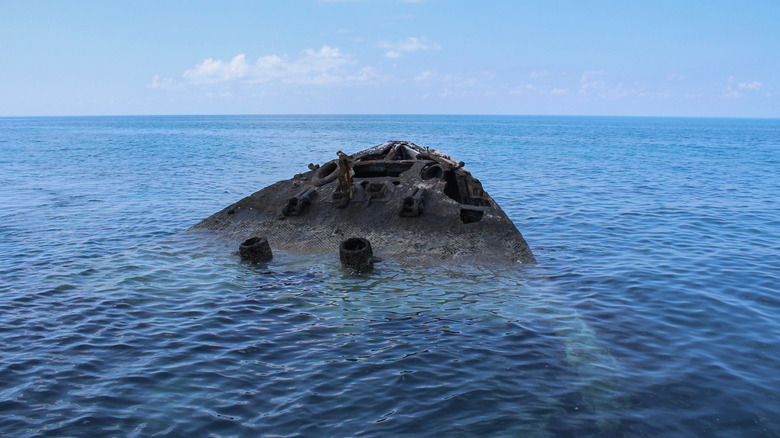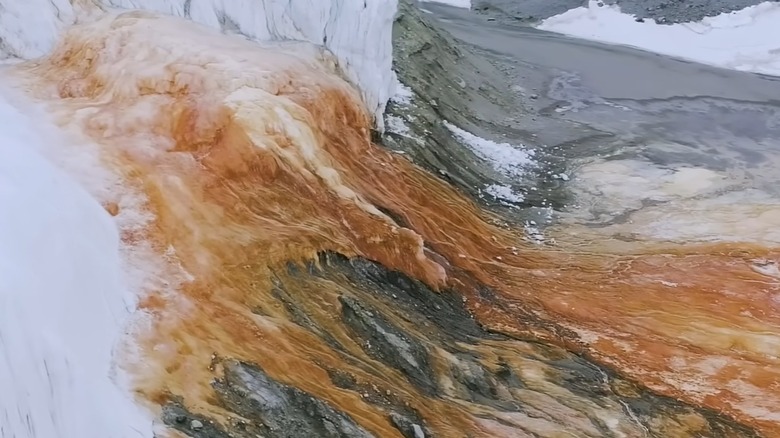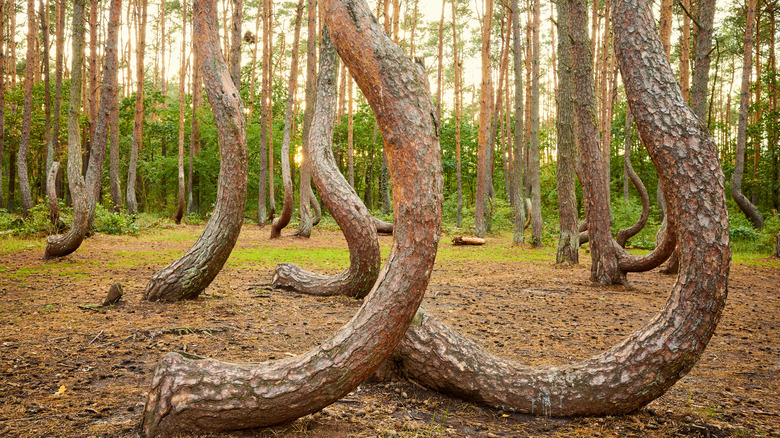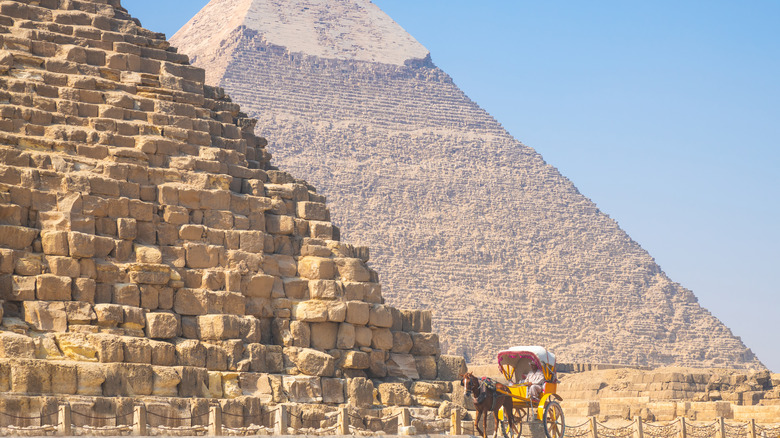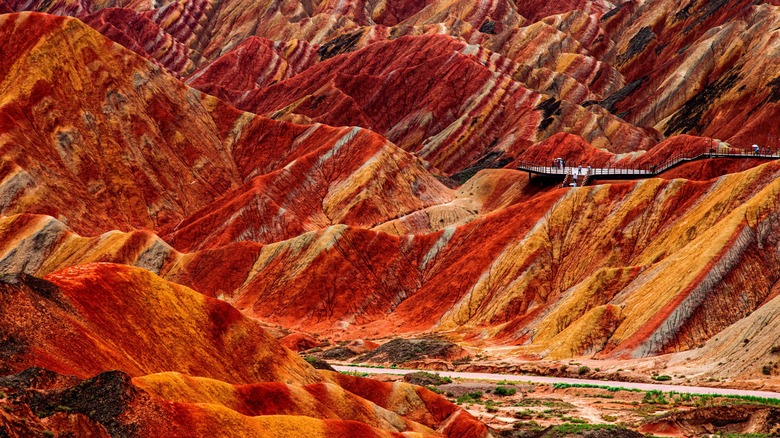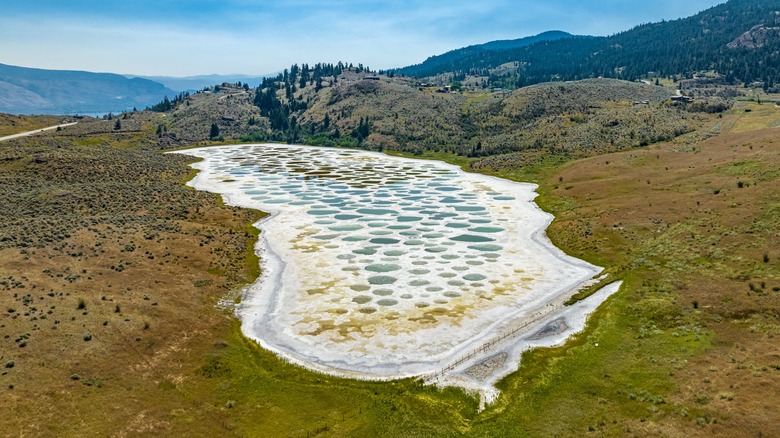Mysterious Places Around The Globe That Leave More Questions Than Answers
Many travelers set out in search of beauty, visiting destinations such as one of Alaska's iconic national parks or a culture-rich city in Japan. Travel takes you away from the daily grind and helps you forget the stress and strictures of your standard routines. It can leave you refreshed and open up your mind — both invaluable experiences. Travel also allows you to encounter scenarios you previously could only imagine.
Though many sights and sites will make you feel humbled and inspired, others will have you scratching your head. From structures built thousands of years ago to natural phenomena that defy belief, many spots around the globe will leave you with more questions than answers. And, in a day and age when you can easily access information on just about any topic, doesn't that sound like a refreshing predicament to find yourself in?
Pursuing the mysteries of these enigmatic places could have benefits beyond those provided by travel alone. "If we didn't ask questions about what is going on and why, we'd still be at the level of apes," Les Lancaster, Liverpool John Moore University professor emeritus of transpersonal psychology, shared with the British Psychological Society. "Mysteries help us expand our horizons, and give us a greater repertoire for interacting with the world."
Horizontal Falls - Australia
The Kimberly, a wild region in Western Australia with limited roads but rich in Aboriginal heritage, is off the beaten path. There, travelers will find a horizontal waterfall, a phenomenon that looks as odd as it sounds. The cascade occurs in Talbot Bay as a result of tidal interactions. When the tides go in and out at certain times of the day, volumes of water drive between the skinny gaps of gorges in the McLarty Range.
The sheer volume of liquid and the narrow channel combine to cause the water to mimic a cascade, not vertically but laterally. It's an astonishing sight that we've had the good fortune to witness. Traveling against the current of Horizontal Falls on a powerboat gives you a sense of its weird physics. However, rides on the actual falls will become a relic of the past due to the government banning them after 2028.
Bermuda Triangle - Atlantic Ocean
The lyrics of the song "Bermuda Triangle" by Barry Manilow hint at the area's mystery. "Bermuda Triangle. It makes people disappear. Bermuda Triangle. Don't go too near." Ships and planes have, in fact, vanished without explanation in the region of the Atlantic, which forms a loose triangle between Bermuda, the coast of Florida, and the north of Puerto Rico. Based on some estimates, about 50 ships and 20 aircraft remain unaccounted for in the Bermuda Triangle, a pattern that emerged in the middle of the 1800s. Vessels have gotten lost without sending out distress calls and with no apparent equipment malfunctions.
Speculation points to spiritual or celestial forces at play. The scientific community has also put forward theories about these disappearances, ranging from navigational anomalies that cause pilots to make erroneous calculations to mammoth waves that can destroy ships with ruthless efficiency. However, the Bermuda Triangle may be more an urban legend than a legitimate mystery. "According to Lloyd's of London and the US Coastguard, the number that go missing in the Bermuda Triangle is the same as anywhere in the world on a percentage basis," Australian scientist Karl Kruszelnicki told The Independent.
Black Sun - Denmark
On a warm, clear spring or autumn day, the sky above the Tøndermarsken, a reserve in the south of Denmark, may appear a deep, rich blue. As evening falls, pink and purple streak across the horizon, though sections of the magnificent view can instantly turn black as if beset by a Biblical plague. Rather than harbingers of an impending apocalypse, the patches of darkness, known as Black Sun, consist of thousands of starlings performing a swooping, swirling, choreographed dance in the dusk.
The roiling, surging, kinetic ballet of the starlings creates quite the spectacle, a fact not lost on the tour operators who take groups to watch it. While a visual treat, the reason why the birds perform these aerial acrobatics remains a bit of a mystery. Some scientists posit the starlings use the unified displays to fend off predators, while others believe they signal other starlings to roost for the evening.
Blood Falls - Antarctica
The color of blood, wherever it appears, is a shocking sight. The hue is an arresting visual at any time, but seeing it against a backdrop of brilliant white somehow feels more disturbing. Visitors to Antarctica might experience this scenario when they pass by Blood Falls. At the cusp of a glacier named for Thomas Griffith, a British geologist, a cascade of blood-like color appears to spill into the sea.
For many years, nobody knew the cause of the ghoulish phenomenon, and the tongue of red that seemed to protrude from the glacier hinted at an inexplicably sinister secret. However, recent studies have come up with an explanation, even if the mystery feels more appealing. Water containing nanospheres rich in iron under the layer of ice turns red when exposed to oxygen. It sits in a network of rivers and lakes, originating from a reservoir under the glacier, where minerals congregate.
Caño Cristales - Colombia
Caño Cristales can be a hit-and-miss spectacle, depending on the time of year.. During the seasons when rain overruns the country or sunshine makes it the perfect time to visit Colombia's idyllic peninsula off the coast, Caño Cristales is just another river. However, between those seasons, the river fills with multiple colors, forming a liquid rainbow. When the conditions all line up — most reliably in June and November — the river bed showcases hues of blue, green, red, blue, black, and more.
According to folklore, the river once sat within the realm of paradise, but managed to get out and explore the mountainous terrain nearby. The tale is certainly heartwarming, and easy to accept given the rich shades on display. However, riverweed plants that sit on the riverbed actually create the colors when sunlight activates them — a scientific explanation for a seemingly otherworldly occurrence.
Crooked Forest - Poland
In the west of Poland, near the border with Germany, visitors to Krzywy Las will find trees steeped in mystery. The strangely bent trees are not only an odd sight, but their shape has no definitive explanation. Hundreds of trees in this part of the country, also known as the Crooked Forest, rise a short distance from the ground before suddenly contorting almost 90 degrees. They then rise vertically again, making the trunk form a haunting J-shape. Even stranger, the trunks all seem to bend in the same direction, ordered like a battalion of soldiers about to advance.
A number of theories might explain this anomaly of nature. Arborists may have planted the trees and bent them to make their shape conducive to using the wood for furniture. Others believe heavy snow bent the trees when they were young, while another hypothesis states the contortion resulted from gravity.
Easter Island - Chile
Upon arriving on Easter Island, visitors will likely wonder how its giant statues were made and ended up in such an isolated area. The incredibly remote landmass sits more than 2,000 miles from the coast of Chile (here's all you need to know if you want to visit Easter Island for the first time). It's also tiny, about 60 square miles in size. Yet, the island has an outsize reputation for mystery, specifically its statues, or moai, that populate various points of the solitary outpost.
Hundreds of moai appear around Easter Island, some by the coast, others stacked on hillsides. Each has unique features, ranging from different names to how they were painted. Their size is even more incredible, with some weighing almost 200 tons. The ahu, the stone platforms where you'll find the moai, are also notable. Some span hundreds of feet and were designed to hold multiple statues in place.
Fairy circles - Namibia
Namibia, located in the southwestern part of the African continent, is famous for its desert — the oldest on the planet. It's home to the giant, undulating dunes at Sossusvlei, which are especially hypnotic at dusk and dawn. Namibia also draws people in with odd natural phenomena. In the dry land in the nation's west, weird circular shapes appear, spreading across the flat area. The pocked landscapes, known as fairy circles, consist of rough-edged, round clumps that appear haphazardly.
Scientists have not come to an agreement on how the fairy circles form. However, two theories have gained traction. According to one, termite colonies nibble through grass roots, forming a circle on the land that traps water and acts as a reservoir of sorts in the process. Another hypothesis asserts that the grasses arrange themselves in this formation as a way to pool water and survive in the parched conditions.
Kawah Ijen - Indonesia
Fans of almost otherworldly sights should consider a trip to Kawah Ijen, a volcano on the island of Java. Kawah Ijen has not one but two reasons that visitors will look upon it with awe. By day, travelers can gaze onto a vast, vividly turquoise caldera lake, more than a half-mile wide. High levels of acid and metals in the water give it that distinctive hue.
At night, tourists might notice small wisps of blue flames jumping out from parts of the volcano. These flames come from its gases, which are extremely high in sulfur and ignite upon contact with oxygen in the atmosphere. At times, it almost appears as though the volcano has blue lava gliding down its side. The lake also has a place in local mythology, with a Hindu god thought to live in its water and protect the miners who extract sulfur from the volcano.
Nazca Lines - Peru
Part of a Unesco World Heritage site, the mammoth drawings that make up the Nazca Lines extend across the landscape on a plain near the coast of Peru. Their size (some miles long) and age (more than two millennia old) make the geoglyphs outstanding. The austere forms recreate animals and plants; you can see them most clearly from high above, usually in a plane. Some represent animals like spiders, ducks, and llamas, while others resemble people or unknown creatures.
Thanks to the stable, dry conditions in the desert around them, the Nazca Lines have remained intact. Much research has been dedicated to understanding them, from their origin and creators to their reason for existence, but they still confound experts and observers alike. Theories about their purpose range from honoring the gods to charting astronomical movements. Some also insist that aliens created the Nazca Lines.
Pyramids of Giza - Egypt
Made more than 4,000 years ago, the awe-inspiring Pyramids of Giza still have experts stumped by how their creators assembled them. The striking structures with strong angles and forms served as tombs for royalty. The Egyptians built the tombs on mounds that stacked on top of one another and got smaller as they rose, giving them an overall terraced pyramid shape. The Egyptians only began building the smooth pyramids that are famous today during the reign of King Snefru.
The Great Pyramid of Giza rises more than 400 feet into the air and features blocks of stone that weigh 15 tons. From the tools used for the finishing work to the sheer force and ingenuity required to move the massive weights involved, the pyramids are an architectural marvel and an engineering miracle that required the relentless labor of hundreds of thousands of workers.
Rainbow Mountains - China
The multi-hued Rainbow Mountains defy belief, with the stunning colors of the topography responsible for their status as a major tourist attraction in China. The peaks lie within the Zhangye Danxia Landform Geological Park, which sits in a Unesco World Heritage site. Looking at the undulating terrain, visitors might believe that paint covers the slopes and peaks.
The wildly varied hues of the mountains have an explanation. When tectonic plates collided millions of years ago, grand mountains made of stones and sand laced with iron and minerals formed. The iron and minerals faced exposure to the elements, with erosion, weathering, rain, oxidization, and wind all having a hand in creating the kaleidoscope of colors evident today. That said, some people believe a Chinese goddess gave the mountains their many hues by merging rocks of different shades as a way to protect humans from rampant animals seeking to destroy them.
Ringing Rocks - Pennsylvania, United States
In Pennsylvania's Bucks Country, intrepid travelers will find rocks with talent. A large field of weighty boulders contains what has become known as the Ringing Rocks, diabase stones that have a strangely perplexing property: they emit a clear ringing tone when hit with a hammer. Theories abound as to how these rocks came to exist, with some of the more out-there proposals including getting dropped by extraterrestrials or forming through the arcane art of witchcraft.
Perhaps a more plausible reason might have to do with the geological makeup of the Ringing Rocks. A study conducted by professors at Rutgers University suggested that the rocks have molecules arranged in such a way that they move and vibrate against one another when struck (via Acentech). Whatever the reason, the Ringing Rocks remain a puzzling piece of nature and perhaps conclusive evidence of the assertion that geology literally rocks.
Sailing stones - California, United States
The driest and hottest place in the country, Death Valley is one national park travelers should avoid in the summer. It's also a destination where large rocks appear to have a life of their own. The sailing stones, as these boulders have become known, seem to slowly shuffle around a spare desert plain called Racetrack Playa.
The sailing stones don't shift on account of gravity, and animals don't push them. However, they definitely move, as evidenced by the tracks left in their wake. The rocks, made from dolomite and syenite and weighing up to hundreds of pounds, require a precise combination of factors to shift. When the water, wind, and ice come together in perfect union, the sailing stones can glide along the valley floor like languid skaters on a rink. However, this explanation has not stopped visitors from attributing their movement to forces like aliens or energy fields.
Salar de Uyuni - Bolivia
Once a lake, the Salar de Uyuni lost its water thousands of years ago. During the dry season, visitors will see clumps and formations of salt on the surface. It's an eerie scene, a blinding white landscape stretching in all directions, and a once-in-a-lifetime destination you won't want to miss. Legends accompany these massive salt plains.
Local farmers point to the mountains around the flats, saying they were formerly huge people. According to this story, a goddess got involved with two of the mountains and became pregnant. The mountains fought over the paternity of the child, so the goddess sent it far away for the sake of safety. To ensure the child would survive, the goddess covered the plain with milk to feed her offspring, and that milk later turned to salt. Another fable claims the salt flat formed from the tears of a jilted giant.
Spotted Lake - Canada
Located in the Okanagan Valley, part of the interior of British Columbia, the Spotted Lake looks almost cartoonish. For parts of the year, the lake, situated near the town of Osoyoos, seems just like any other body of inland water. However, when the temperatures climb and the air dries out, the lake begins to evaporate. Once the water levels start to drop, scores of small pools appear, creating a canvas of spots in yellow, blue, and green hues.
Looking at the spots, travelers might feel that they act as a portal to an underwater fairyland or home to other mythical creatures, but minerals like calcium and magnesium have created this circular scene. While a pleasant-to-behold artistic tableau, it's also a sacred site for the First Nations people who live in the Okanagan Valley. To them, the circles in the lake, which they named Kliluk, have powerful restorative qualities.
Stonehenge - England
Someone assembled the mammoth rocks that form a circle at Stonehenge more than 4,000 years ago. How these giant stones got into place remains somewhat of a mystery. Workers used holes with angled sides, wooden panels, and stakes to position the rocks with ropes and frames. Getting the stones vertical required counterweights, while wood platforms allowed workers to get the lintels on top of them.
Nobody knows for certain why Stonehenge exists, though religion may have played a role. According to legends, Stonehenge has more mystical origins. Merlin, a mighty wizard, reportedly used his magic to move giant stones arranged in a circle from Ireland to the plains in the west of England. Another piece of lore claims that the Devil transported the boulders to England to trick a woman out of some gold, while one tale claims that the stones were once dancing giants.
Uluru - Australia
Uluru, a giant rock, erupts from the middle of a vast plain. Along with Kata Tjuta, another large rock formation nearby, Uluru can trace its genesis back more than 500 million years. A slow, gradual process involving the erosion of mountains by rain, the covering of land by a sea that eventually disappeared, and tectonic shifts created these grand wonders. Yet, while this explanation seems reasonable, seeing these rocks sprouting from otherwise flat surroundings may make you question how they appeared.
Uluru is composed of a rock called arkose, and minerals in it — especially iron — make it flaky and red (arkose is normally gray). Uluru is massive by any metric, but the majority of it actually extends miles below the surface of the ground. While a humbling spectacle on its own, the local Aboriginal peoples view Uluru as an important cultural totem linked to the origin of their ancestors.


